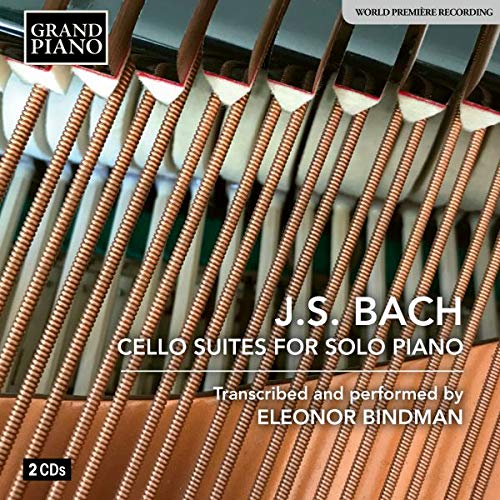By Barry Lenson
Prepare to be surprised when you listen to the new 2-CD release of Eleonor Bindman playing her piano arrangements of Bach’s Cello Suites. Ms. Bindman’s arrangements faithfully include the notes you will find in the original Bach, but have become works that are new, unique, and completely satisfying on their own terms.

That is just one of the discoveries to be made in this new recording, which follows an earlier, excellent 2-CD recording, The Brandenburg Duets of four-hand transcriptions of the Bach Brandenburg Concertos that Ms. Bindman performed with fellow pianist Jenny Lin.
In nearly every way, the Cello Suite transcriptions feel very different from the Brandenburgs. How did that happen, and what was the thinking behind this new release? We spoke with Ms. Bindman, and here is what she had to say.
Classical Archives: What motivated you to transcribe and record these pieces?
All my transcriptions are motivated by the desire to play my favorite music on the piano. My first major piano transcription – Mussorgsky’s Night on Bald Mountain – was made because I just loved the orchestral piece and wanted to have more Mussorgsky to perform. Max Reger’s piano-4-hands version of the Brandenburgs has been on my music shelf for decades but proved too unwieldy when I tried to play them with my piano duet partner. So I made a new, playable one, thinking that a good arrangement would really enrich the piano-4-hands repertoire. The Cello Suites by nature are suitable for amateur pianists so this new set is also intended to provide more playable Bach for them.
Classical Archives: Was there a particular cellist whose way of playing influenced how you heard and transcribed the Cello Suites?
Eleonor Bindman: The transcribing focused on the Anna Magdalena manuscript, as my goal was to stay true to the original. I listened to quite a few cello recordings: Casals, both of Yo-Yo Ma’s recordings, Fournier, Rostropovich and many more, as well as other instrumental transcriptions, plus older piano arrangements (both highly harmonized) by Leopold Godowski and Joachim Raff.
As far as interpretation, I found myself partial to Fournier and Rostropovich: the former for elegance and the latter for sound and directness. How I heard the Suites on the piano largely developed as I experienced playing them myself. I did intentionally try to imitate a “guitar” sound in some dances, a “cello” sound in some Sarabandes, etc.
Classical Archives: These transcriptions are wonderful to listen to, but won’t pianists at many levels of proficiency be itching to play them too?
Eleonor Bindman: Absolutely, and the recordings of both Brandenburg Duets and The Cello Suites for Piano are – in my mind – just transitional steps to making the scores available to pianists, which is the real goal of my work. I believe that playing Bach is not only joyful, but also a healing and spiritually transformative process, as long as we are relaxed while playing.
Professional keyboardists have access to a treasure trove of his legacy, but many amateur pianists find counterpoint too difficult to relax and enjoy, as I have found over decades of teaching. I am hoping that The Cello Suites for Piano and my Stepping Stones to Bach series of arrangements can fill that gap for intermediate adult pianists and young students.
So far the feedback has been quite gratifying: I have gotten emails from older people who have arthritis, for instance, who were expressing their gratitude for having some accessible versions of their favorite music to play and enjoy without struggling to play it “correctly.” Recently, many people have written saying how much nicer the lockdowns (in Europe) have been with their pianos and the Cello Suites score.
The Brandenburg Duets, of course, were intended to replace the Max Reger piano-4-hands version which has been in circulation for 100 years, yet no famous performers have ever played it in public or recorded it, except Anderson and Roe, who recorded Concerto #3. One would think that if that version were acceptable, we would hear it a lot more.
It has been a long haul, but fortunately, the Russian “Muzyka” publishing house just issued my “Brandenburg Duets,” just in time for the 300th anniversary of the Brandenburg Concertos. I am now hoping that someone will be interested in publishing my Cello Suites transcriptions. In the meantime, it is available from my website.
Classical Archives: You have said that Vladimir Feltsman influenced your approach to interpretation. Have there been other teachers and performers who guided you?
Eleonor Bindman: Mr. Feltsman is a pianist of extraordinary skill and intellect and his Moscow Conservatory pedigree and performing experience were a privilege to be exposed to. Whereas I can’t say that he influenced me in my latest projects, he has heard me play many transcriptions of Liszt, Busoni and Rachmaninov and encouraged my interest and experimentation in that direction. Transcriptions require a unique approach to the keyboard and to sound, depending on the original source. Learning to produce different types of sounds as well as getting some technical tips from Mr. Feltsman was invaluable.
Of course, I have been influenced by most Bach interpreters of note, whether hearing them live or on recordings and videos. The recordings of Gould taught me the value of individuality and experimentation, performances of Schiff are wonderful lessons in scholarship, Hewitt’s flexible phrasing is unique and beautiful. I love Feltsman’s meditative approach to Bach and Dinnerstein’s joyful rendition of the Goldbergs.
My personal taste finds great affinity for the recordings/performances of Grigory Sokolov, his intensity of focus, wonderfully diverse ornaments and epic ritardandos; I wish more people knew him in the U.S., but he doesn’t travel here. And the greatest summary of Bach-related thought is embodied in the books and lectures of Rosalyn Tureck. Her insights and expression of overarching ideas about Bach’s output are absolutely essential to my learning process. She had a truly bird’s-eye view of the material and embraced a “universalist” approach to Bach by being an accomplished harpsichordist and clavichordist who did not enlist into the “period instrument” movement.
Classical Archives: How was transcribing the Cello Suites different from transcribing the Brandenburgs?
Eleonor Bindman: The Brandenburg Duets process was like the Appalachian Trail, while the Cello Suites was maybe an overnight hike. The complexity of counterpoint, deciphering the various clefs of the score, exclusion of secondary material and then distribution between four hands made the Brandenburg project nearly a three-year affair. It required an extraordinary amount of focus and attention to detail for many months. In comparison, the Cello Suites were transcribed in a couple of months. All I needed to do was to put the single line, interspersed with some chords, into piano notation and divide it reasonably between two hands.
Classical Archives: Did you start that process at the keyboard, start with the printed music first, or do it in some other way?
Eleonor Bindman: My process starts with examining the score and entering the data into music software. With the Brandenburg Duets, I first entered the cello/bass line, then the solo (concertino) lines or the ripieno violins and then chose the “filler,” depending on what was logistically possible. Then I listened to orchestral recordings to understand which parts become more prominent in performance, using the Freiburg Baroque Orchestra as a model. Then I played each part, determined the hand-crossing issues, edited, and found another pianist to try it out.
After that there were a few more rounds of editing, and throughout it all there was a whole lot of printing. I had to generate many different types of scores: a primo/secondo on the same page for easier looking and the recording, a side-by-side one with matching measure numbers for the run-throughs. I also ended up making a very wide horizontal score on legal-size paper because the texture is so dense that minimizing page turns is a big advantage when performing. A friend of mine actually made a “Bachumentary” about my years of transcribing the Brandenburgs, you can see on YourTube.
With the Cello Suites, the process was less involved, as I already mentioned: I looked at the manuscript plus a few scores and entered the data through a midi keyboard into Finale. Then I distributed the notes on the grand staff and listened to dozens of recordings as a reference for editing: listening for mistakes I might have made in data entry (I have perfect pitch) and deciding which way to go when there were inconsistencies between the scores.
After that was finished, I started learning the Suites, performing them whenever possible and developing my own interpretation since a recording was imminent and I needed to make some decisions for the 36 movements to sound interesting on the piano. At that stage I listened to other instrumental transcriptions of the Suites as well as to my favorite orchestral and keyboard Bach recordings, actually making playlists and notes as to which movement I wanted to possess a certain character. For example, the Gavottes from Suite 6 were modeled on a wonderful interpretation of the Orchestral Suites dances by the Academy of St. Martin in the Fields.
Classical Archives: Thank you for these comments, which we believe will increase awareness of the complexities of the work you have done and the appreciation of the arresting beauty of your recordings.
Now all you members of Classical Archives, it is time to start listening to the Bach Cello Suites in a unique and new way . . . on the piano! And we have Eleonor Bindman to thank.





I’ve listened to Eleonor’s playing her transcriptions over and over, in awe. It is wonderful to be able to read and watch/hear her to give a better appreciation of her astounding and transporting work.